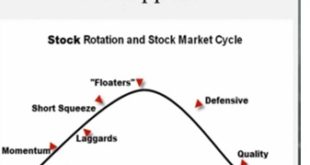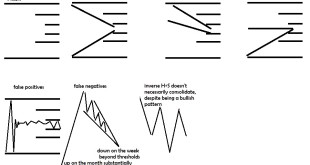If you were playing the 3 crows pattern, you would want to set 1 or 2 alerts and 1 buy. The buy would be a stop buy at/above the pattern high which signifies the breakout point. The alert you would want to set is at the pattern low which signifies a breakdown. If this alert triggers, you take your buy and move on…. or…. perhaps you instead exchange it for an alert, or wait a couple days.
Sometimes, you get bluffed out of the hand on a bad flop, and as it turns out you would have picked up a hand on the turn or a big draw on the turn and hit the river card. It happens. FIO gave us a bad flop as expected, breaking below the “low”. However this was a failed breakdown and swung up above the pattern high signalling a breakout. I don’t really know if you would count this as a breakout at this point as the pattern failed initially. Unfortunately although encyclopedia of candlestick patterns is a very great reference book there are many unanswered questions such as “Does this still count as a breakout?” and “at what point after the pattern has shown is a breakout in either direction no longer considered a breakout.” and “how does the ‘percentage meeting price target’ and ‘avg 1,3,5,10 day gain’ change when a 5% stop is employed? A 10% stop?”
Personally the setup still looked good to me. Breaking above new relative recent highs after making 3 failed attempts to really break down (a triple bottom of sorts) and as it broke out of the consolidation range, it looks like a buy. Well you could have a 10% gain from $20 to about $22 If you captured the best of the move. Even if you just get a 3 day hold, you probably get 5% from $20 to $21. Such gains in a short amount of time are great, but does this really mean buying is the right move?
In poker, sometimes the cards turn over and you would have caught runner runner. Your 35 of spades on a 4 of spades as the only card in the board may have then given you an open ended straightflush draw and then you happened to hit. Unless you are making an advanced play where you call with the intention of bluffing or semibluffing the turn and can take the pot down often enough for it to be worth your while, you should almost always fold and move onto the next hand if the odds are against you and the cost of playing is too much which it probably will be with only a gutshot and backdoor draw. In this case, the triple bottom may have been enough “supporting evidence” such as a “tell” that opponent is likely to be bluffing or weak, and that calling or raising here to bluff the turn may be a good move. But certainly, there’s nothing but missed opportunity (and there may be greater opportunity elsewhere anyways) by folding, and it isn’t a bad move to fold. There are a whole lot of cards that may help you pick up a draw. Your opponent may give you a free card to see the river, and then try to bluff the river if he is a player who has a weak hand and isn’t going to bet on every street. In other words, if you hit runner, runner, you may get some more chips out of it. Additionally, if your opponent checks the turn and you have no draw, you may try a complete bluff. You don’t have to break even on your bluffs since you are getting decent odds, you have the possibility of hitting the long odds gutshot draw, and you have even longer odds of hitting runner runner and getting a lot more chips out of it. So there is the argument to be made that making the “bad play” can be marginally profitable if you call to bluff later on. That play depends not on your hand, but your opponent and your read. How this relates to the stock chart FIO is that it is one of those situations that in fact invalidates the breakout when their is first a breakdown, but then it swings around and breaks to new relative highs after also making a triple bottom. The “tell” is there, and this hand/stock/chart is now playable. Does that mean you definately should play it? No but there is an argument to be made either way.
Sometimes it’s best to just let the hand go and comment “nice hand, sir” and stick to the system of patience and only trading when you KNOW the odds are in your favor and you knowexactly how you want to go aboutthe trade. You have a choice in poker/stocks to try to make every move and trade/play anything remotely close to that of a hand that suggests it can be profitable. Sometimes your decision will actually have a negative expected value, but it may just keep you sharp and the marginal decisions you make that do turn out to be right will make you close to break even on the marginal hands to slightly up and if you can master the marginal decisions, you perhaps can make a killing. But if you are wrong, you perhaps are on the other side of the “killing” that is being made. The argument for the strategy is that being involved more allows you to see more situations and gain more experience and eventually will allow you to perhaps improve your ability at making those marginal plays. In the market, or table, you may become better in tune and this “loose aggressive” strategy (or loose passive aggressive) may actually turn out best.
But this strategy is on the verge of insanity and can cause you to form bad habits just as easily.
The other option is patience. Take the known edge at risk of potentially earning less than you could but providing more security of gains. There’s nothing that says you have to be super active when playing poker or stocks. Poker you actually may need to worry about how people perceive you as a player and playing more hands may get you more chips when you have a winning hand because of that perception. You also are forced into hands because of “blinds” and “antes” where as nothing but inflation causes a loss in value if you don’t play, and that is very mild compared to the potential gains you may make.
If you are going to play this, I would instead play it as the triple bottom breakout and that is an entirely different “style” of play or another completely different “deck”. That has to do with “price patterns” The way to deal with price patterns isn’t as cut and dry as “hold for 5 days and then sell for average expected gain of X”. You have to set stops, maybe use a trailing stop, and at some point take profits, either at the target, or use the target price to readjust the stop. It’s a much more “advanced” and “complicated” way to play and is similar to “small ball” poker than Daniel Negreanu made so famous. Perhaps the “big money” is in price patterns. The upside will far outweigh the downside and the holding period for winning stocks will be much longer. But the potential dangers and ways you can screw up taking profits too early to not compensate for your losses, or too late until they turn into a loss, or cutting your losses to quickly that you lose to commissions and don’t give the stock enough room to run, or not quick enough which can cause bit losses that are difficult to come back from. Making trades more often has drawbacks. The obvious one is commissions (or in poker, the rake). But it also has advantages. Even when you know the odds are against you, trading more often allows you to gain more experience. There may be other variables that also can potentially put the odds back in your favor such as a “tell”. There are more variables to monitor than just a candlestick pattern, and price patterns are the next variable that can provide a “tell” on the direction of the stock. Of course, there are several others just as one particular tell is not the only indicator in poker.
If you enjoy the content at iBankCoin, please follow us on Twitter






I have read it more than once to get the idea. would like to know whats the success rate of this setup.
http://ibankcoin.com/hattery/2012/08/02/follow-up-on-3-black-crows-candle-stick-pattern-as-a-poker-hand/
http://ibankcoin.com/hattery/2012/08/01/candlestick-charts-as-a-poker-hand/